When even experts can’t figure you out: CNS-restricted HLH

At first it seemed like motion sickness when 5-year-old Emily threw up after spinning around outside, or during car rides. No one thought much of it. But gradually, she also developed headaches and stomachaches. Her walking and balance started to falter. She became lethargic, and complained about something in her eye. Her face took on a slight asymmetric appearance.
Her parents, Jim and Beth, wondered if a serious case of flu in the recent past had kick-started something in Emily. Neither would have suspected that she had a rare disease among rare diseases, the first of four cases ever reported.
A screaming headache
One severe headache landed Emily in her local hospital west of Boston. “I called emergency response,” Beth says. “She was screaming.”
The doctors found abnormalities on Emily’s brain MRI scan and thought she might have cancer. They referred her to Boston Children’s Hospital.
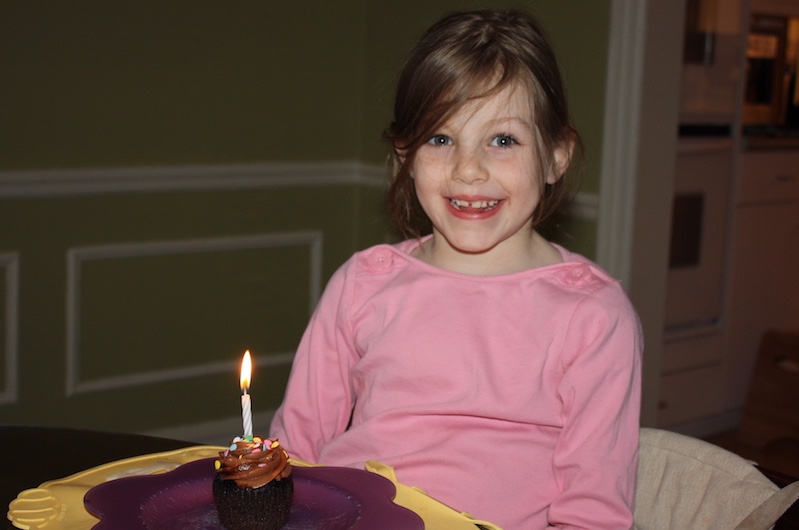
Neurologists who saw Emily in Boston Children’s emergency department disagreed. Initially, they thought she could have acute disseminated encephalomyelitis or ADEM, a short-term autoimmune disease sometimes triggered by infection. In ADEM, the body’s immune cells attack the nerve fibers’ insulating coating of myelin. This demyelination can cause many of the symptoms Emily was having — headache, nausea and vomiting.
The doctors expected Emily’s symptoms would quickly go away with steroid treatment. “It was characterized as a bump in the road,” says Jim.
Searching for a treatment
But Mark Gorman, MD, who directs the Pediatric Neuro-Immunology Program at Boston Children’s, wasn’t so sure. Emily’s brain MRI showed a pattern unusual for ADEM lesions. Still, he started Emily on the steroid prednisone.
While prednisone did diminish her nausea and headaches, Emily’s gait and balance were getting worse and she began to have tremors. And her other symptoms came back when they tried to wean the prednisone away.
Still not knowing what Emily had, Gorman and his resident at the time, Leslie Benson, MD, decided to add IV immunoglobulin, often used for autoimmune diseases. The results, at first, were dramatic.
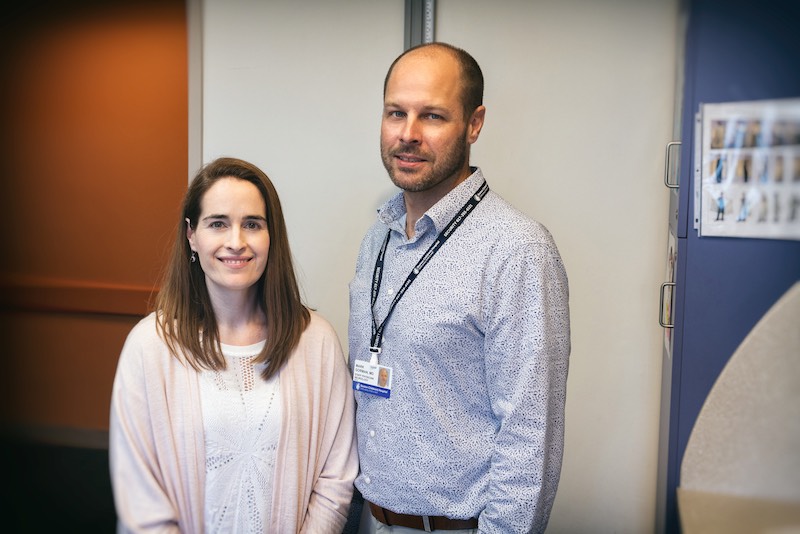
“It was the old Emily,” Beth says. “She wasn’t sluggish, her rate of speech was better.”
But then the improvement stopped. After three months, they stopped IVIG altogether.
And Emily plummeted.
“Nobody seemed to know what to do”
In October 2010, back in the hospital, Emily underwent a brain biopsy.
“They had narrowed it down to several conditions it might be,” says Jim. “The biopsy was the only way to differentiate between those possible root causes.”
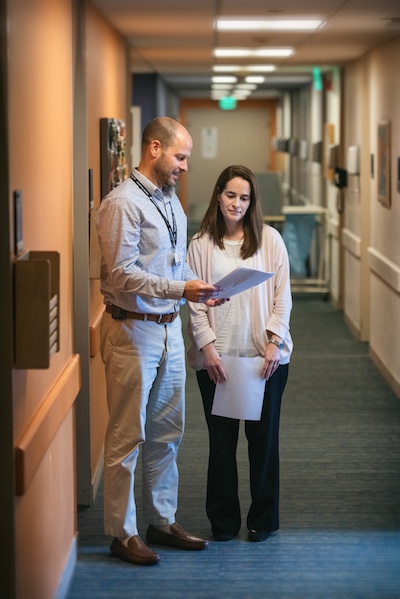
The biopsy ruled out a demyelinating disease, and instead showed brain inflammation. Gorman and Benson thought it looked like inflammation of the brain’s blood vessels, or vasculitis, whose origin was likely autoimmune. They planned to treat her with a protocol developed in Toronto: six months of the chemotherapy drug cyclophosphamide (Cytoxan), followed by 18 months of mycophenolate (CellCept), a drug used after transplant to suppress the immune system.
But in the summer of 2011, after Emily transitioned from Cytoxan to Cellcept and had her prednisone tapered, her symptoms worsened. Then her next MRI called everything into question.
“They saw a ring on her scan and now were back to thinking it was maybe infection, maybe cancer,” Beth says. Such an MRI finding is unusual in inflammatory brain disease and can indicate unusual infections by things like fungi, especially in patients on immunosuppression.
“All kinds of people came in – cancer people, infectious disease people,” says Beth. “The doctors presented her case at a few conferences, and nobody seemed to know what to do.”
An ominous MRI scan
A second brain biopsy ruled out cancer and infections. It also got Gorman and Benson thinking about natalizumab (Tysabri), a drug approved for another autoimmune condition, multiple sclerosis (MS), that blocks white blood cells from entering the central nervous system. The doctors didn’t think Emily had MS, but they hoped it would curb the inflammation in her brain. The team still could not pinpoint her diagnosis, so in early February 2012, at Gorman’s suggestion, the Bracketts went to the Mayo Clinic for another opinion.

The Mayo Clinic doctors weren’t all in agreement about Tysabri. Some simply suggested upping Emily’s steroids. Other potential diagnoses were considered, including CLIPPERS (chronic lymphocytic inflammation with pontine perivascular enhancement responsive to steroids).
Gorman and Benson also began to wonder if Emily had a rare inflammatory disorder called familial hemophagocytic lymphohistiocytosis (HLH). In HLH, the immune system produces too many activated immune cells and high levels of cytokines, proteins that further activate the immune system, causing damage to other blood cells and organs. However, Emily did not show any of the classic signs of inflammation in the blood and other organs. Her testing was normal, except for one abnormality that was attributed to her medications.
It was starting to feel desperate for everybody.
Ominously, Emily’s MRI at Mayo showed new markings. Two weeks later, Emily had a major seizure, her first. “That kind of tilted the scales against just continuing the steroid treatment,” says Jim. “It was starting to feel desperate for everybody.”
Trying to calm Emily’s immune system
So, for the next three years, Emily received Tysabri under a compassionate use protocol. It required special approvals from the hospital and the FDA, since it had never been used for a condition like hers and it carried a risk of serious side effects.
“We were trying to find a therapy that would stabilize her,” says Benson, who is now assistant director of the Neuro-Immunology Program. “Emily’s immune system was so dysregulated that we were willing to do anything to calm her immune system down.”
The Tysabri initially improved Emily’s brain scans and symptoms. Her tremors, gait and speech didn’t worsen.
But eventually, Tysabri, too, stopped working.
Rare among rare
In January 2015, at Gorman’s suggestion, the Bracketts took Emily to the Undiagnosed Diseases Program at the National Institute of Health. There, she underwent a soup-to-nuts evaluation that eventually confirmed Gorman’s and Benson’s earlier suspicion. (Boston Children’s, because of its experience with rare disease, has since become part of the program’s network of sites.)
“They rebooted the whole process,” says Jim. “They did a genome workup and confirmed, in June, that it was HLH. It was pretty remarkable after all those years and all those treatments.”
Other specialists initially told us, ‘you’re crazy.’
The sequencing also showed that Beth and Jim are both carriers of the HLH mutation. Emily’s was one of the first known cases of familial HLH that was restricted to the central nervous system, without causing inflammation elsewhere in the body.
“Other specialists initially told us, ‘you’re crazy,'” Gorman says. “But if you dig enough in the literature, there are hints of it, buried in tables.”
Reboot the immune system, banish HLH?
HLH caused by a genetic mutation has a standard treatment protocol: a blood stem cell transplant, preceded by high-dose steroids and several rounds of chemotherapy. Also used for cancer, blood disorders and other inflammatory diseases like lupus, the transplant process wipes out the bone marrow and immune system and replaces it with blood and immune cells from a healthy person.
The mantra was, ‘she can’t have HLH because she doesn’t have systemic inflammation.’
It offered Emily a potential cure. But the stem cell transplant team at Dana-Farber/Boston Children’s Cancer and Blood Disorders Center needed a firm diagnosis before undertaking the high-risk procedure. Gorman and Benson had to convince the team that the HLH mutation that had been identified was causing Emily’s disease. The team was skeptical, since no one had ever seen a case of HLH that affected only the brain.
“The mantra at the time was, ‘she can’t have HLH because she doesn’t have systemic inflammation,’” Gorman says.
Weighing the risks and benefits
A stem cell transplant would require Emily to stay in the hospital for more than a month. It posed a risk of potentially lethal graft-versus-host disease (GVHD), in which the donor cells attack the recipient’s cells. There was also a risk that the new cells would never take hold, leaving Emily without a blood system or immune system.
“It was a huge leap to transplant Emily, our first patient,” says Hojun Li, MD, PhD, a hematology/oncology fellow on the team, now an attending physician in stem cell transplant. “There was zero evidence that this was the right thing to do. It took us a month to make the decision.”

Stem cell transplant team leader Christine Duncan, MD, with Li and Barbara Degar, MD, a national expert in HLH with systemic inflammation, warned that a stem cell transplant would be difficult and risky. But Emily and her family didn’t hesitate.
Prepping for transplant
Upon hospital admission, Emily received a central line, which she and her parents nicknamed “Larry.” Through it, under two weeks of close watch, she received alemtuzumab (Campath), melphalan and fludarabine, powerful chemotherapy drugs designed to wipe out existing her immune system and blood stem cells.
Her parents took turns staying with her. Child life workers, volunteers, hospital clowns, karate lessons, art projects and special food treats helped lighten the experience. Other visits came from social workers, psychologists, physical therapists, dieticians, and, of course, nurses. The Palliative Care Team (PACT) paid Emily close attention, learning her interests, watching TV with her (primarily Dr. Who) and generally helping her cope.
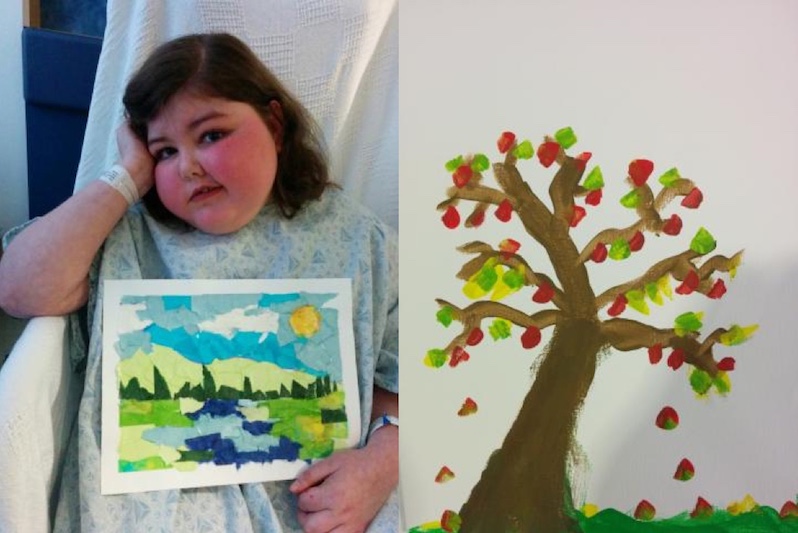
Otherwise, her days involved “pretty much nothing,” says Emily, now 14. “Lying in bed.”
She tolerated the chemotherapy well, but not the injections. “I’m needle-phobic.”
“I will never quit”
As the days before transplant crawled by, Emily was increasingly homesick. She missed her animals — “two cats, two dogs, two fish, two chinchillas and one hermit crab.”
Still, Emily’s determination to defeat her disease kept her motivated. She and Jim decided to personify HLH, inventing an arch enemy (voiced by Jim), taunting yet feeble enough for Emily to silence with her own angry, determined voice.
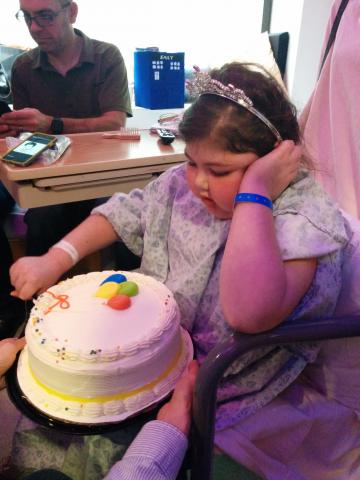
“I will never, ever, ever quit until HLH is out of my body,” she told her dad.
Four days before the transplant, Emily turned 11. She woke to happy birthday wishes from the nursing staff, her dad, the clowns and the PACT team. In the early afternoon, a small army of nurses, doctors, clinical assistants, and specialists burst into the room with a huge cake, specially prepared to fit Emily’s “low-bacteria” diet, required because of her depleted immune system.
Finally, on October 13, 2015, blood stem cells arrived from an unrelated donor. Emily received them in a six-hour-long infusion. As a defiant gesture against HLH, she stayed sitting in a chair, refusing to retire to bed.
Gathering HLH cases
To this day, no one knows why Emily’s HLH affects only her brain.
“HLH is taught as a multi-system disease,” says Gorman.
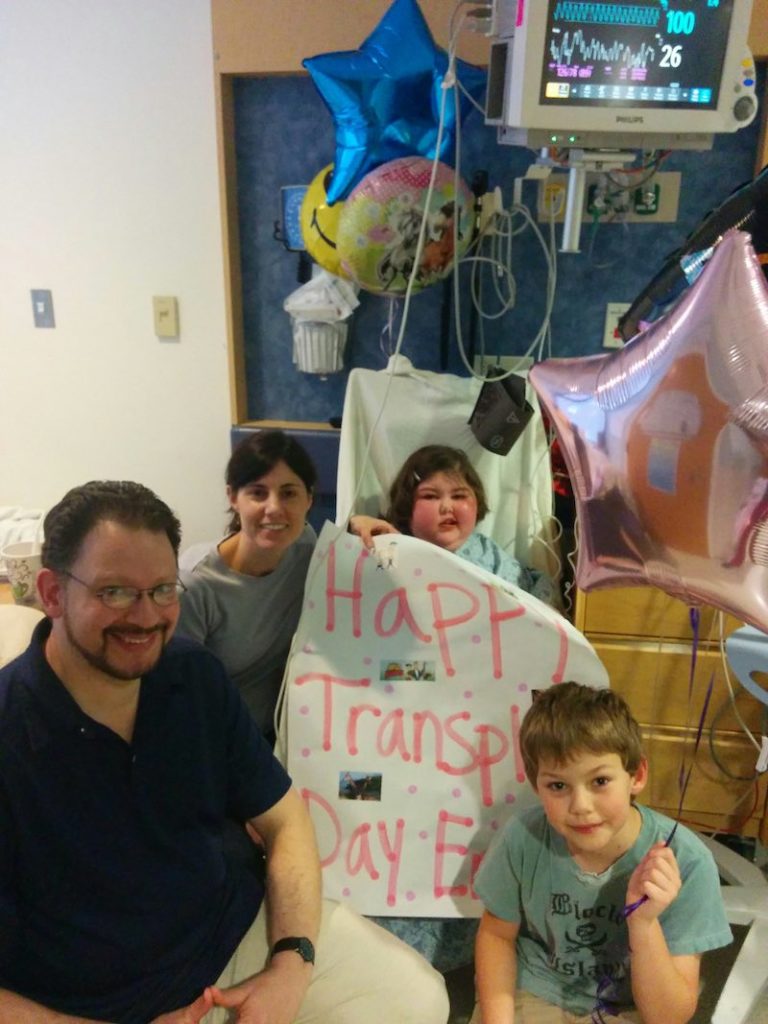
Gorman, Benson and Lauren Henderson, MD, MMSc, an attending in rheumatology, have since identified and described three other children with CNS-restricted HLH in the journal Neurology: Neuroimmunology & Neuroinflammation. The children have various genetic mutations, also found in systemic HLH, that ultimately eliminate or disable natural killer cells and other immune cells that eliminate infectious agents and limit inflammation.
In Emily and one other child, the mutation disrupts perforin, a protein that punches holes in infected cells. When perforin cannot function, the infection cannot be eliminated, and inflammatory reactions spiral out of control. Experts on systemic HLH at Cincinnati Children’s Hospital ran tests that confirmed that Emily had low perforin levels and low numbers of natural killer cells.
“Nobody had ever characterized this disease before,” says Li. “There are some patients in whom neuroinflammation may have preceded systemic inflammation, but none with neuroinflammation that kept recurring.”
As Li, Duncan and their colleagues recently reported in Blood Advances, the other three children also had a stem cell transplant, and two had a marked benefit. The third girl, whose sister had HLH, had abnormalities on her brain MRI but no symptoms; she was able to avoid the symptoms of HLH altogether.
Nobody had ever characterized this disease before.
Additional cases are trickling in. “We consider HLH as a possibility in essentially every patient we see,” says Gorman. “If we have reasonable suspicion, we go right to the genetic testing.”
Living life without HLH
Li says the ultimate hope is to be able to treat HLH with gene therapy, which would mean a much milder pretreatment, avoid the need to find a suitable stem cell donor and eliminate the possibility of GVHD. Instead, patients would have their own blood stem cells isolated and treated to correct the genetic defect.
Meanwhile, three-plus years out from her transplant, at age 14, Emily has an HLH-free immune system. She is past the days of highest risk for GVHD. And she’s been weaned off steroids, which had caused many unpleasant and severe side effects, as well as other immune-suppressing drugs.
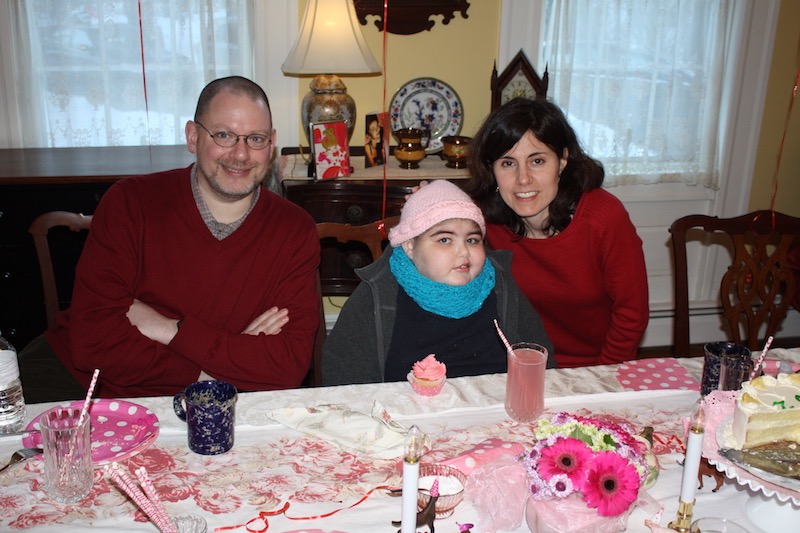
The disease has left its mark. While improved, Emily’s speech is still slow, her walking and balance are still impaired, and she still fatigues. She gets around her house with a walker and uses a wheelchair when the family is out and about. Her memory and cognition seem somewhat improved and the headaches are gone.
“Our expectations were bounded between a worst-case scenario of simply maintaining the status quo and a best-case scenario of seeing the deficits from HLH reverse,” says Jim. “The reality is somewhere in between.”

But with HLH gone, Emily can focus, for the first time, on living her life and pursuing her passions — music, horses, the family pets and painting. She starts high school this fall, has begun to swim regularly and is taking vitamin D to build up bone density lost through years of steroid treatment. She says she would like to be a nurse someday.
Beth agrees that Emily’s compassionate, kind nature would make her well suited to offer support to patients. “Her life now seems to be more about her personality being defined by her interests, and not by a chronic illness.”
Learn more about Boston Children’s Neuro-Immunology Program and the Pediatric Stem Cell Transplant Center.
Related Posts :
-

Navigating school with a neuroimmune condition
Fifteen-year-old Sarah had been challenging her dad to card games all week — and on Saturday, she finally beat him. It ...
-

Thanks to Carter and his family, people are talking about spastic paraplegia
Nine-year-old Carter may be the most devoted — and popular — sports fan in his Connecticut town. “He loves all sports,” ...
-

No limitations: How Flora found answers for MOG antibody disease
Flora Ringler’s fifth birthday didn’t turn out as she had hoped. She and her family were vacationing in ...
-

Genomic sequencing transforms a life: Asa’s story
Asa Cibelli feels like he’s been reborn. The straight-A middle schooler plays basketball and football, does jiu jitsu, is ...





